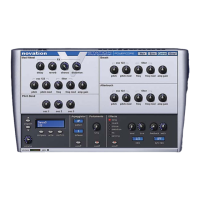Oscillator Extras
PRE-GLIDE Knob
A Pre-glide is applied to the pitch of the oscillators starting at a pitch determined by the Pre-
glide amount in semitones. Gliding up from a pitch occurs when the display indicates between
-12 to -1, and gliding down from a pitch occurs when the display indicates between 1 to 12. At a
setting of 0, no pre-glide is applied.
The time it takes to complete the Glide is determined by the PORTAMENTO knob on the MAIN
panel. The Pre-glide is triggered with every note received.
VOICE MODE select LEDs
These options determine how the program will play - i.e. polyphonically or monophonically.
When set to MONO or MONO AG, the Program plays monophonically (i.e. only one note can
be sounded at any one time). If a chord is played on the keyboard, it will be noticed that as each
individual note is released, the note sounding will revert back to the nearest played note.
The MONO AG setting enables ‘Auto glide’ (portamento) to be triggered whenever a note is
played on the keyboard before the previously held down note has been released (legato
playing). Using ‘Auto glide’ in this way can greatly add expressiveness to a Program. It is
especially effective when applied to lead type sounds.
The monophonic settings are often useful when replicating sounds in the ‘real world’ which
would normally be played monophonically, for example a bass guitar.
As their name implies, the POLY 1 and POLY 2 settings allow polyphonic operation.
POLY1 allows successive playing of the same note(s) to be ‘stacked’ together, gradually
producing a louder sound texture as the note(s) are repeatedly played.
With POLY2, if the same note(s) are played repeatedly, they will use the same synthesizer
voices as used previously, thus avoiding the ‘stacked note’ effect.
PORTA MODE select LEDs
Determines the type of curve applied when PORTAMENTO is used. Two types of curve are
available, Exponential and Linear. Linear Portamento sweeps through note intervals at a
constant rate. When Exponential Portamento is used, the glide effect gradually speeds up as it
reaches the new note:
OSC 1+2 SYNC Button
This button synchronises Oscillator 1 to Oscillator 2. When the oscillators are synced, Oscillator
1 is the ‘master’ oscillator to which Oscillator synchronises. Depending on the interval between
the two oscillators, you can create new waveforms with oscillator sync enabled and if you
sweep Oscillator 2 independently of Oscillator 2 with, say, the LFO or Mod Env or the pitch
bend or mod wheel, you can create tearing lead lines and basses.
58 CONTROLS panel / Operation

